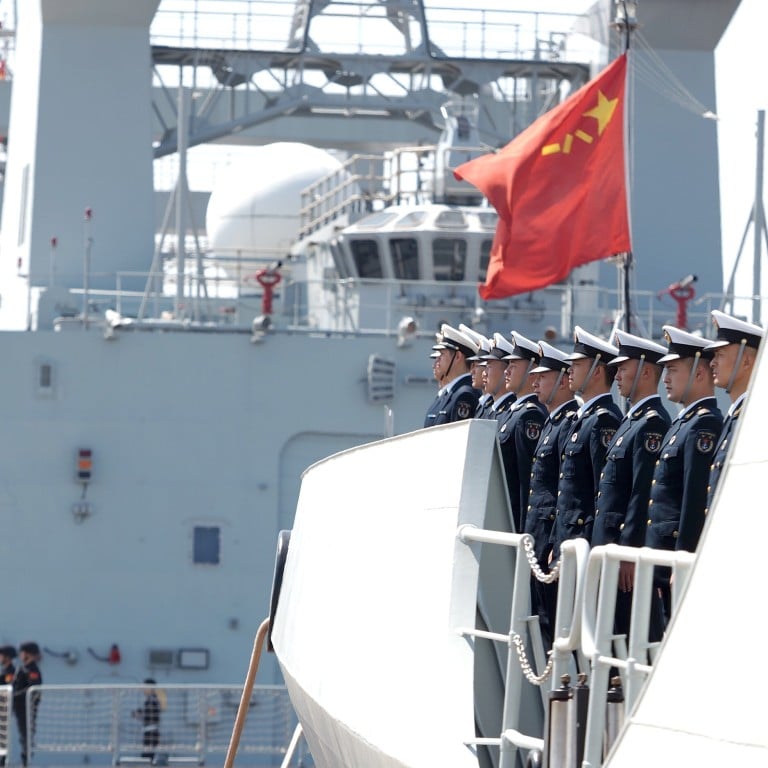
Size of China’s navy may be closing gap on US fleet but what can the PLA do with just one overseas naval base?
- The US maintains nearly 800 military bases in more than 70 countries and territories
- If not keen to enter alliances, China could use access agreements and other arrangements to have strategic access abroad, says analyst
According to the US Department of Defence 2020 annual report to Congress on Chinese military power, China has surpassed the US in terms of naval fleet size.
“The PRC [People’s Republic of China] has the largest navy in the world, with an overall battle force of approximately 350 ships and submarines, including over 130 major surface combatants … In comparison, the US Navy’s battle force is approximately 293 ships as of early 2020,” said the report which was released in September.
Analysts said expanding the navy fleet was aimed at protecting China’s overseas interests, especially while Beijing was starting infrastructure projects abroad, but it also created a challenge. Some said China had too few overseas bases to support its ambitions.
The United States maintains nearly 800 military bases in more than 70 countries and territories despite recently closing hundreds of bases in Iraq and Afghanistan, but China so far has only one base in Djibouti.
“We said in the past that we would never build an overseas base but now we build one. Why?” Jin said. “Will China copy the US to seek hegemony in the world? No. We have to protect the Chinese maritime interest far away.”
Xi tells China’s military ‘be prepared to respond’ in unstable times
While the US Navy is far larger than the PLA Navy by tonnage, China’s frantic shipbuilding schedule quickly narrowed that advantage. The US Office of Naval Intelligence predicts China’s overall naval “battle force” will be around 425 ships and submarines by 2030.
China has a robust and efficient shipbuilding infrastructure with more than 20 yards supporting naval surface ship construction over the last decade as well as dozens of commercial shipyards that exceed the largest US shipyards in size and throughput.
Timothy Heath, senior security analyst from the US think tank Rand, said China – having the world’s largest fleet at hand – needed greater overseas military access to protect its extensive interests.
“Lacking overseas bases is a problem for China because China is so dependent on markets, energy and natural resources in distant locations, such as the Middle East, Africa, and Latin America … [and Belt and Road Initiative] projects are very vulnerable to damage and disruption, which could have a tremendous impact on the economy of China and the world,” Heath said.

Although the PLA has developed into a powerful force, it lacks the ability to project much of that power beyond China’s shores, because it lacked overseas bases, Heath said.
“Currently, China lacks such bases because such arrangements typically require alliance-like commitments, which Beijing is reluctant to make,” Heath said. “China does not necessarily follow the US model, but could instead take the form of access agreements, logistics facilities and other arrangements.”
Heath expected China to seek a variety of access arrangements. “Simply gaining more access for navy ships to stop and refuel would be helpful if granted in more places and perhaps the most common form of military access China will seek. This might mean dual-use ports managed by Chinese state-owned enterprises,” Heath said.
Malcolm Davis, a senior analyst in Defence Strategy and Capability at Australian Strategic Policy Institute, echoed Heath’s forecast.
“In terms of bases, I think these are inevitable and we are seeing China work towards this goal through its Belt and Road Initiative. They are securing access to – or in some cases control of – ports that whilst commercial in nature, could support PLAN [PLA Navy] operations in the future,” Davis said.
US must keep pace with China on military spending, analysts say
China has indeed acquired ports worldwide, a move that has worried many countries.
Pioneering Chinese company Cosco began operating a container port in Piraeus, Greece, in 2008. China has gained a foothold in Europe’s three largest ports: Euromax in Rotterdam, the Netherlands, of which it owns 35 per cent; Antwerp in Belgium, in which it has a 20 per cent stake; and Hamburg, Germany, where a new terminal is being built.
Davis said “there is great concern in Australia about Chinese efforts to use the BRI as a means to gain access to bases and airbases through commercial investment in dual-role facilities … Given the record of Chinese harassment of foreign fishing vessels in the South China Sea, the concern would be that we would face aggressive Chinese activities that could challenge our maritime security interests close to our eastern seaboard.”
Zhou Bo, a retired senior colonel and now a senior fellow in Tsinghua University’s Centre for International Security and Strategy, said China’s national needs justified its expanding naval fleet.
“China is the only major country in the world that hasn’t achieved a full reunification and is confronted with tricky maritime issues in both the South China Sea and the East China Sea, so the Chinese naval power has to be increased to protect China’s sovereignty and national integrity,” Zhou said.
Zhou said China needed a growing navy to protect its overseas interests and offer a public good to the international community, notably through the Gulf of Aden escort mission. “Many Chinese projects in foreign countries are in troubled regions, and some sea routes along the maritime Silk Road are dangerous too.”
But Zhou Chenming, a Beijing based military expert, said China’s defence policy was defensive in nature and there was little need for China to build overseas bases.
“China’s expanding navy is mainly used to counter the threats in its adjacent seas. The US sent many aircraft carriers and warplanes to the South China Sea, and they sometimes passed through the Taiwan Strait, a place so close to the Chinese mainland that it made Beijing feel threatened,” Zhou Chenming said.
The South China Morning Post approached China’s defence ministry for comment about plans for future overseas bases but has not received a response.

